Conserving Anti-Apartheid Banners
In July 2022, three anti-apartheid banners from the 1980s were acquired by the museum, two by Anthony Evans and one by Gerda Roper.
The banners were made for and used by the Wales Anti-Apartheid Movement (WAAM). This group vigorously campaigned for an end to racism and the apartheid system in South Africa. They began as a regional branch of the British Anti-Apartheid Movement (AAM), but they split in 1981 when it became clear that they would garner more support with a distinctly Welsh identity. Under the leadership of Hanef Bhamjee, WAAM was active until the first democratic election in South Africa in 1994 (The National Library of Wales 2021).
The two banners by Anthony Evans, who was an active member of WAAM, were treated in the National Museum of Wales’ painting conservation studio. They presented very different challenges, as both were created with materials at hand with the purpose of being taken out onto the streets rather than hung in a museum.
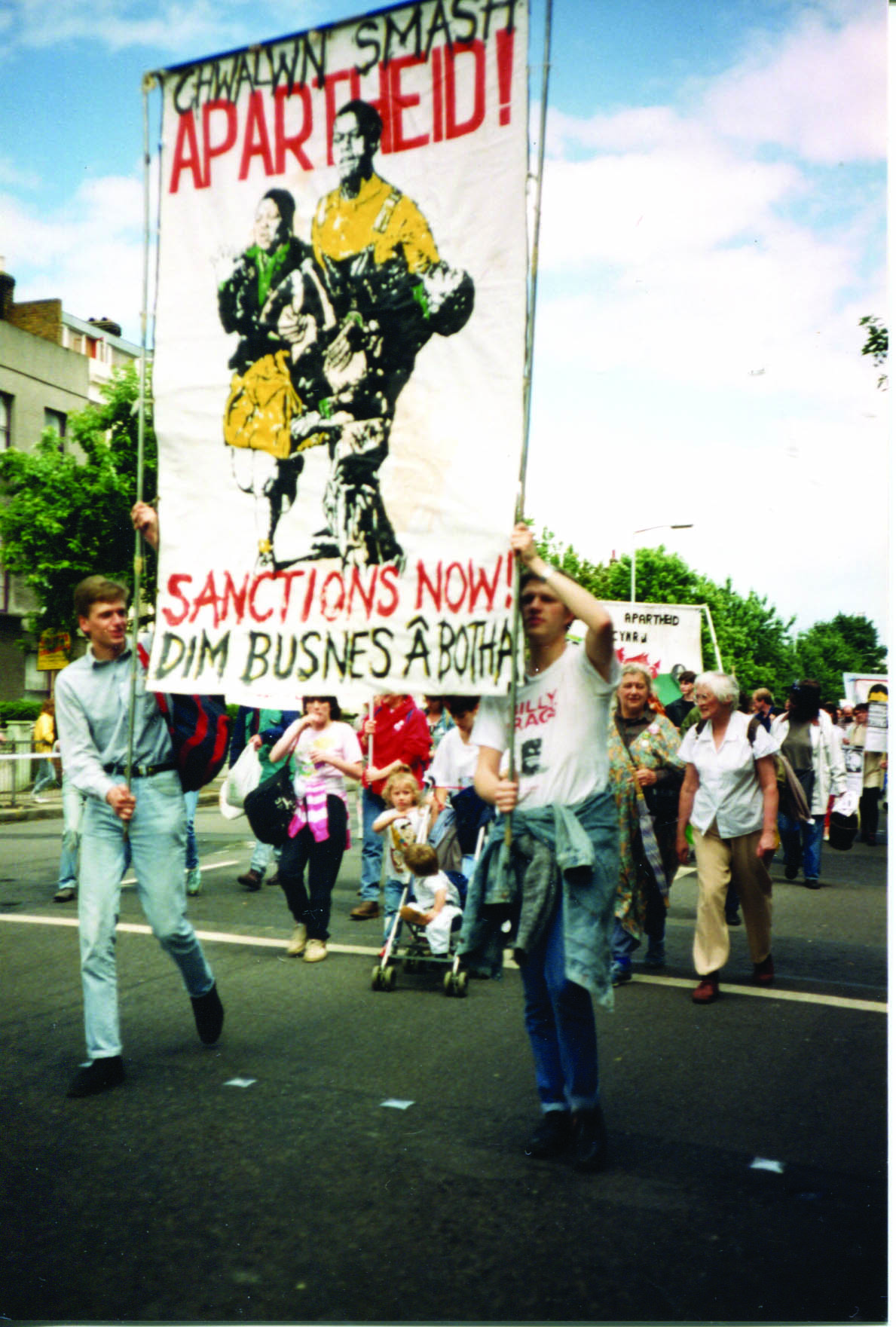
Sanctions Now! banner on a protest in the 1980s
Nelson Mandela
This banner was made in the mid-1980s with household paints applied onto an unprimed canvas. The banner is covered in signatures of protesters and supporters of WAAM. According to Evans, it was made with the intention to be signed as, “an autographed book”. The signatures date from both the protests in the 80s and the memorial service of Hanef Bhamjee held in June 2022. Quite a few of these later signatures go onto the bare canvas, which is exposed from paint loss.
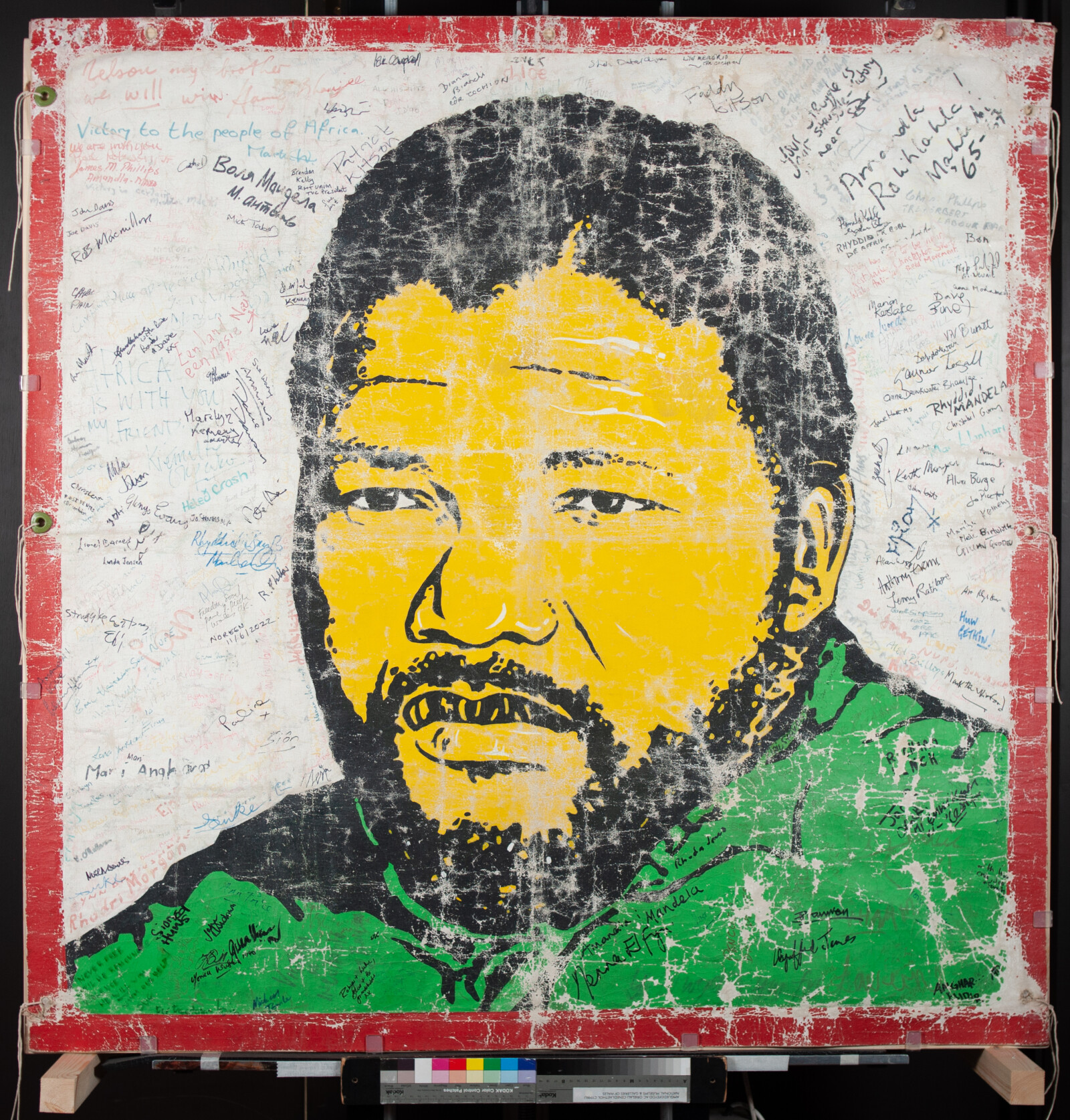
F2022.80_AT_01_Whole front after treatment
© Anthony Evans. Photograph ©Amgueddfa Cymru – Museum Wales
The banner was in a very vulnerable state when it came into the studio. Years of protests, of being unrolled and rolled again, had taken a toll on the banner. Lines of paint loss follow where the banner had been folded. The entire painted surface was cracked and the paint was actively flaking off. The canvas was stapled to a wooden batten along the top edge, but there was nothing to hold it in place and provide a support for the paint layers. Movement of the canvas could cause more paint loss in the future.
As a paintings conservator, I’m used to working on artworks that were made to be hung on a wall with a purpose to invite admiration and interpretation. For this banner, I was very aware that I wanted to treat it differently, even if the materials and artist’s technique was similar to a modern painting. The banner’s condition was a direct result of how and why it had been made, and how it had been used by protesters. While we needed to find a way of stabilising the banner so it could safely be displayed and stored, many of the go-to conservation methods for stabilising such a damaged painting would change the appearance and structure of the banner, which we wanted to avoid.
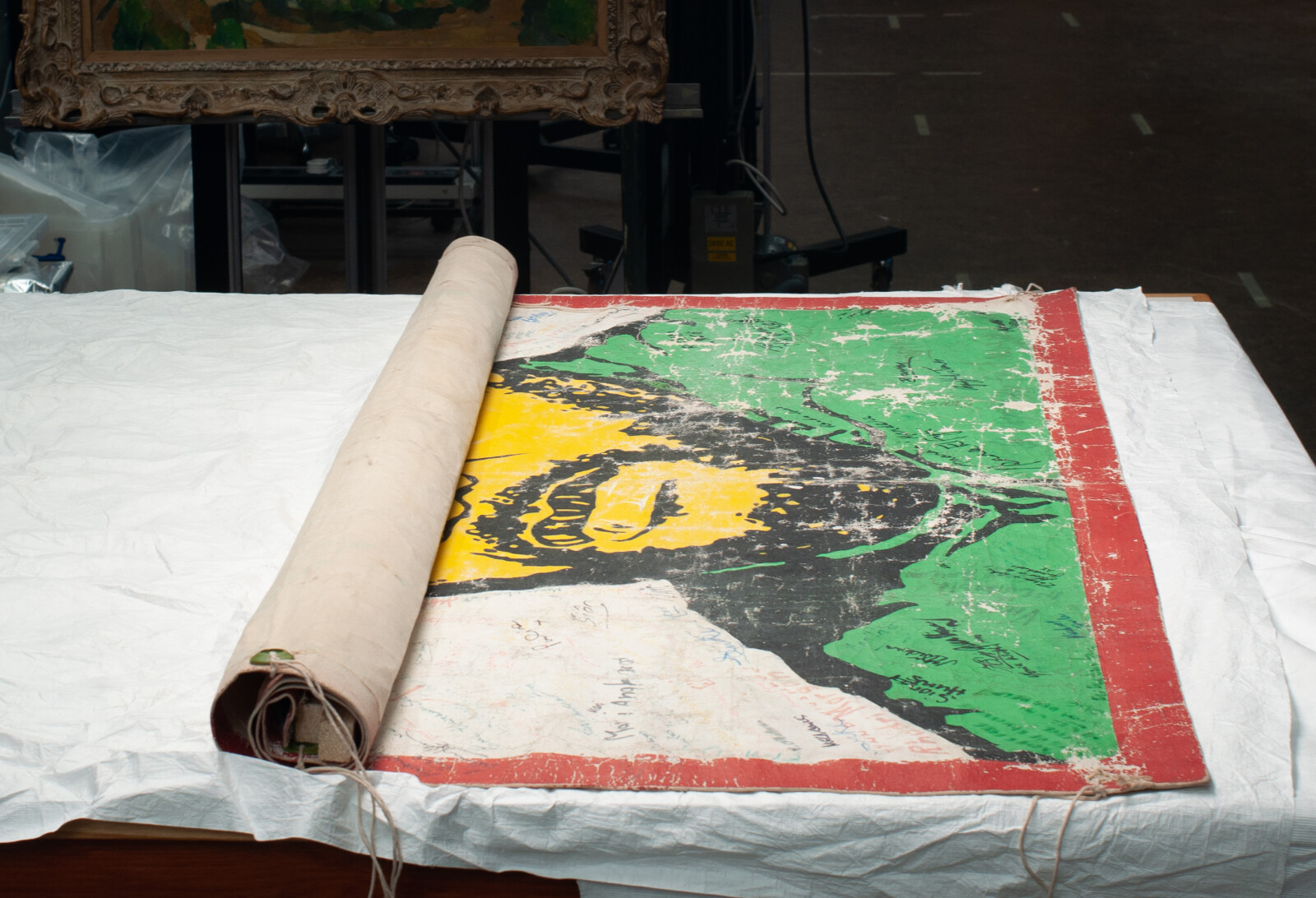
Unrolling the banner at the beginning of the treatment
© Anthony Evans. Photograph ©Amgueddfa Cymru – Museum Wales
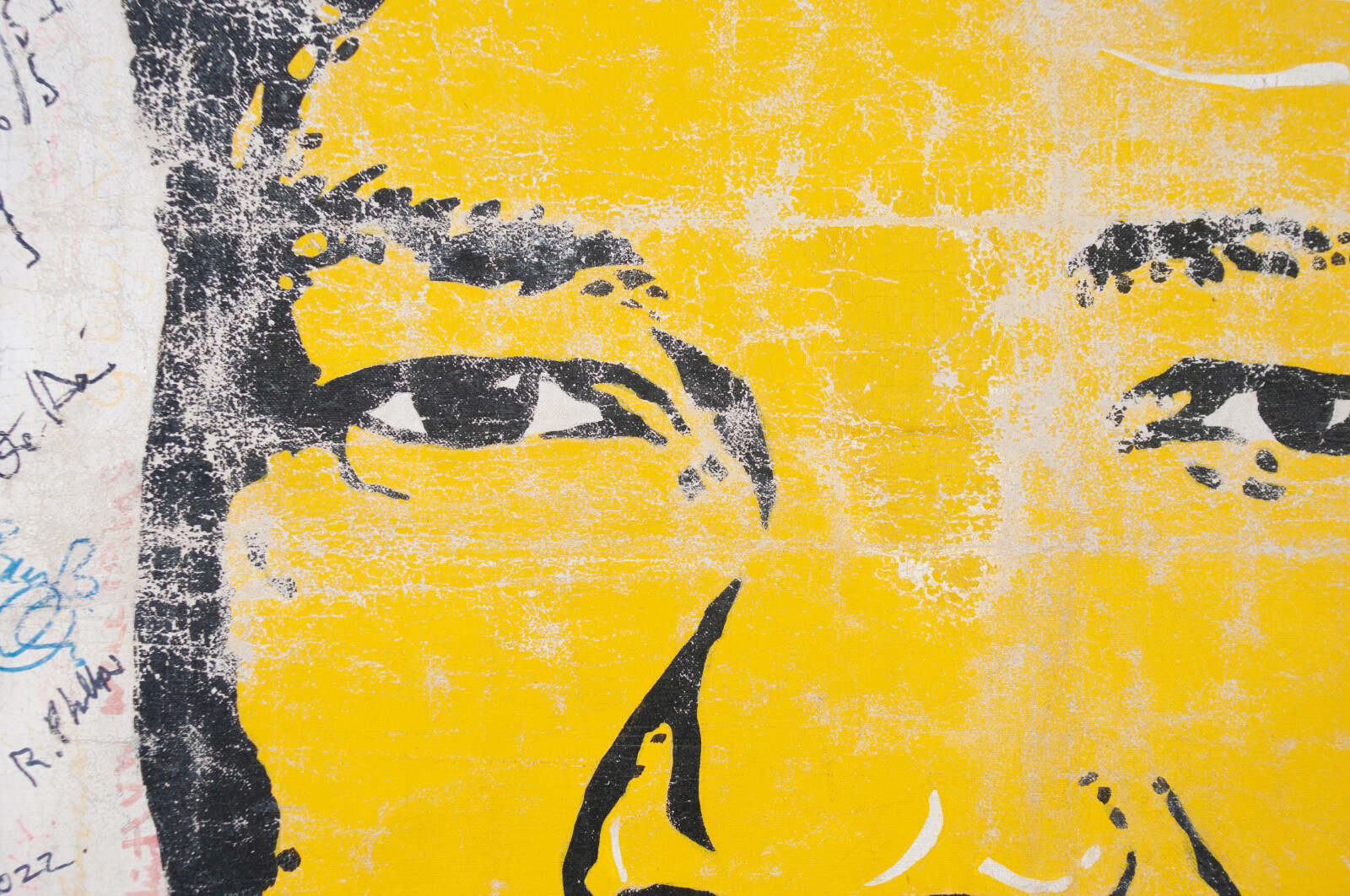
Detail showing extent of paint loss and flaking
© Anthony Evans. Photograph ©Amgueddfa Cymru –Museum Wales
Future risk vs intervention
In conservation, you often have to make decisions about balancing risk to the object with being able to see and appreciate the artwork as it was intended. Risk can come in different ways; it can come from a method of treatment changing something fundamental about the object or from not intervening at all and it deteriorating over time, or perhaps from the environmental conditions needed to display it (for example, fading might occur from being displayed in the light). As conservators, we are constantly trying to balance these risks. For this banner, not doing anything would result in the continued deterioration of the banner. However, to make sure no paint fell off in the future, we would have to do something drastic, like flattening and lining the canvas and stretching it onto a stretcher so the paint was properly supported. This would mean the paint was safe, but it would also change the appearance of the banner and remove some of the features that show the history and character of the banner.
To strike a balance, I decided to pursue a course of action that would stabilise the banner enough to be displayed but would leave it in a condition that would need to be monitored over time and would reduce the ability for it to travel.
Treatment
The flaking paint was consolidated with isinglass adhesive. Every part of the banner was consolidated several times to make it secure enough to move off the table we had unrolled it onto. The banner was then attached onto a wooden frame, which allowed me to brush a different adhesive onto the back of the canvas. An insert was made for the back using a fluted polycarbonate board and polyester wadding to support the canvas. The front of the banner was held onto the wooden support with Perspex clips. This allowed us to display the banner upright with enough support, but without changing the appearance of the banner.
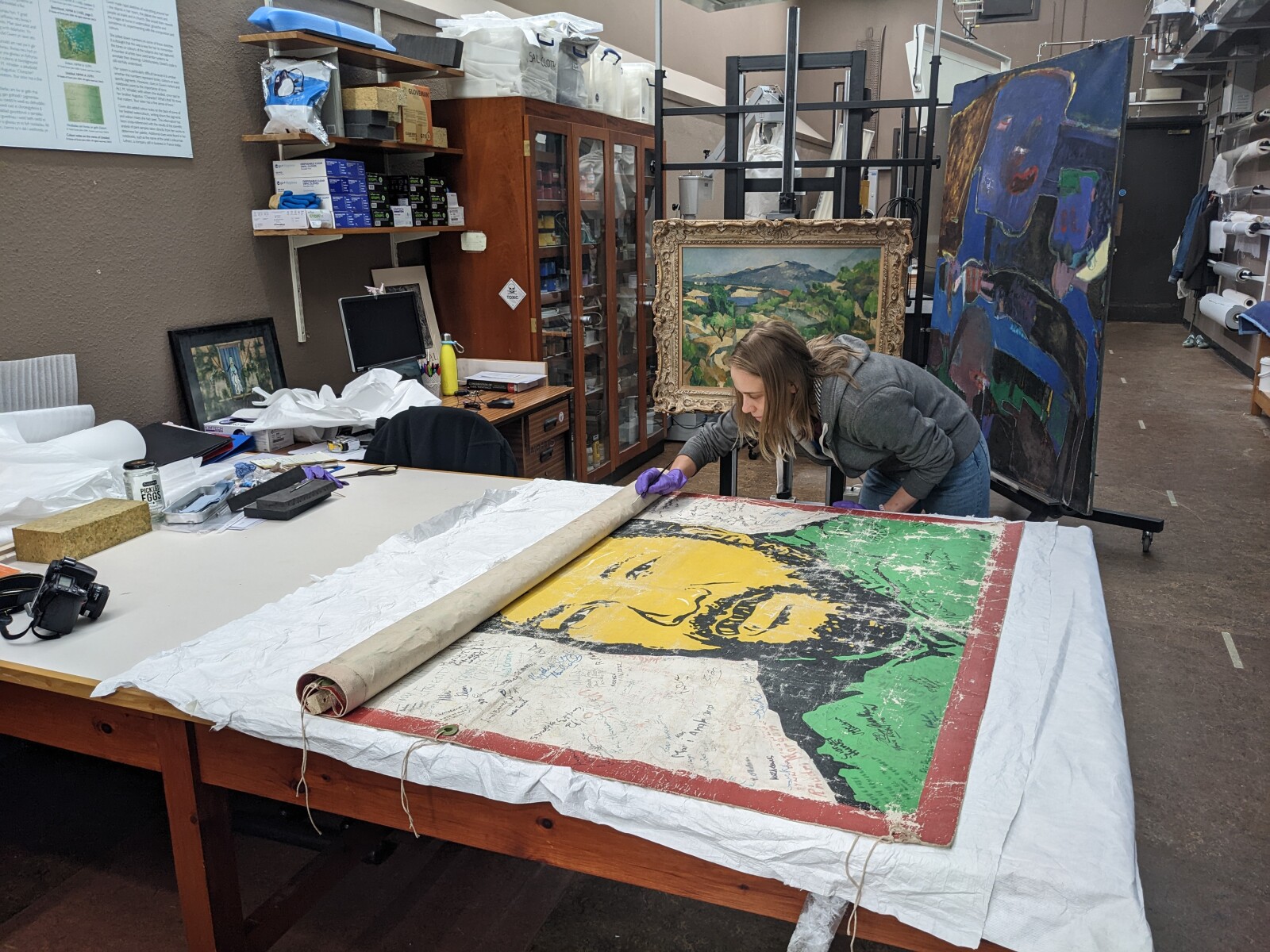
Putting back loose flakes of paint while unrolling the banner
© Anthony Evans. Photograph ©Amgueddfa Cymru – Museum Wales

Applying adhesive to the back of the banner
The paint losses were left unfilled so that the new signatures that went onto the canvas could remain visible and we also wanted to place a greater value on the history of the banner rather than the painted image.
Sanctions Now
Anthony Evan’s Sanctions Now is made from alkyd paints and an old plastic movie projector screen. A wooden beam adds support to the upper edge of the banner, as well. The image on the front of the banner is a copy of a now-famous photograph taken during the Soweto Uprising in South Africa by Sam Nzima on June 16, 1976. Black school children led a series of demonstrations against white-minority rule after Afrikaans was introduced as the instructional language in black schools. An estimated 20,000 students gathered in the streets of Soweto to protest and were quickly met with police brutality. The image captured by Sam Nzima is of 12-year-old Hector Pieterson, who was fatally shot by South African police. He was carried to a clinic by Mbuyisa Makhubo while Hector’s sister, Antoinette Sithole, followed. Nzima’s picture became an icon of the Soweto Uprising and helped galvanize the anti-apartheid movement (Baker 2016). An amended logo from the Anti-Apartheid Movement adorns the back of the banner. Anthony Evans added the Welsh dragon to the group’s taijitu, or yin yang, symbol due to the importance of Welsh identity within WAAM.
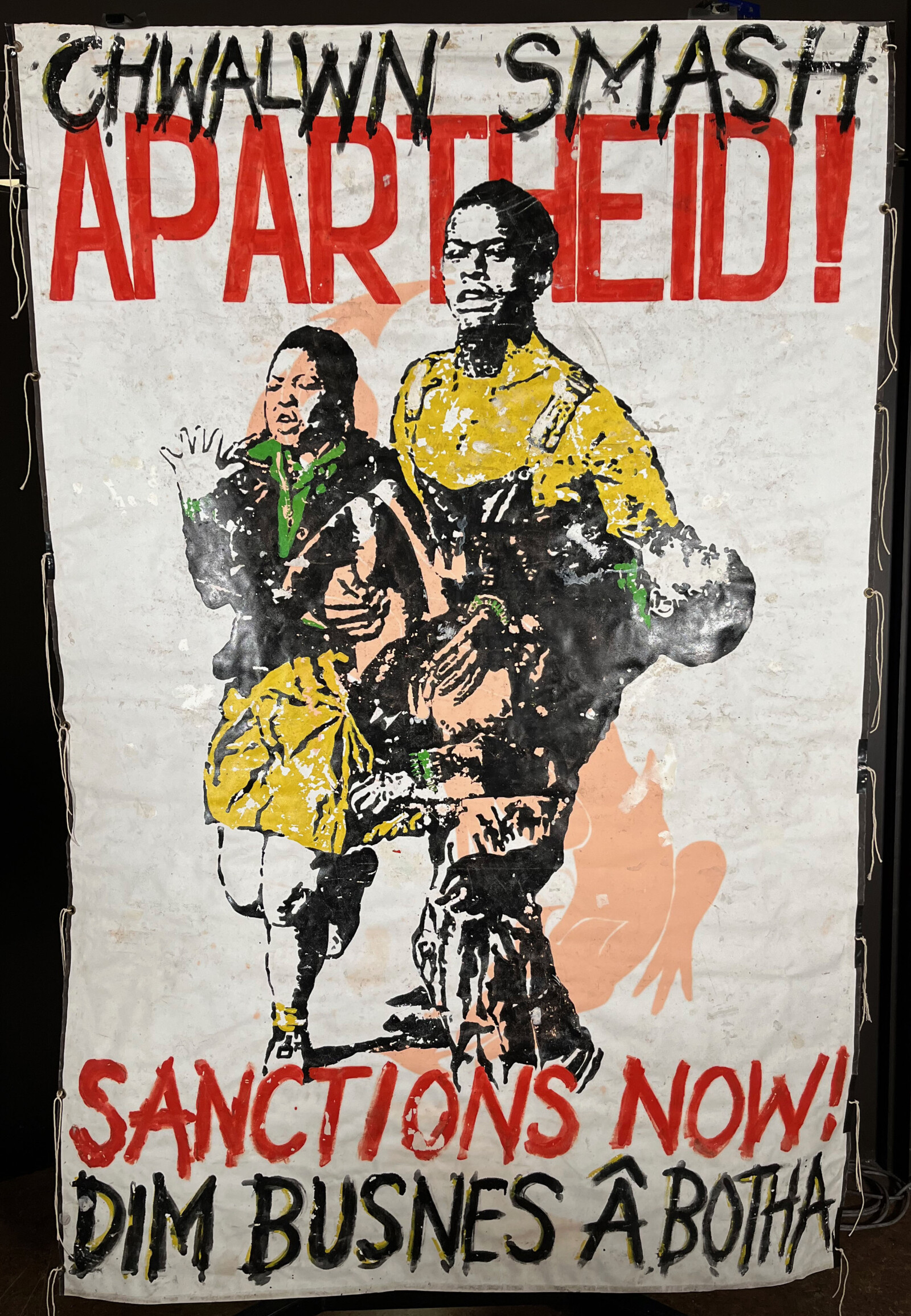
F2022.80.2 (Sanctions Now) Front After Conservation Treatment
© Anthony Evans. Photograph ©Amgueddfa Cymru – Museum Wales
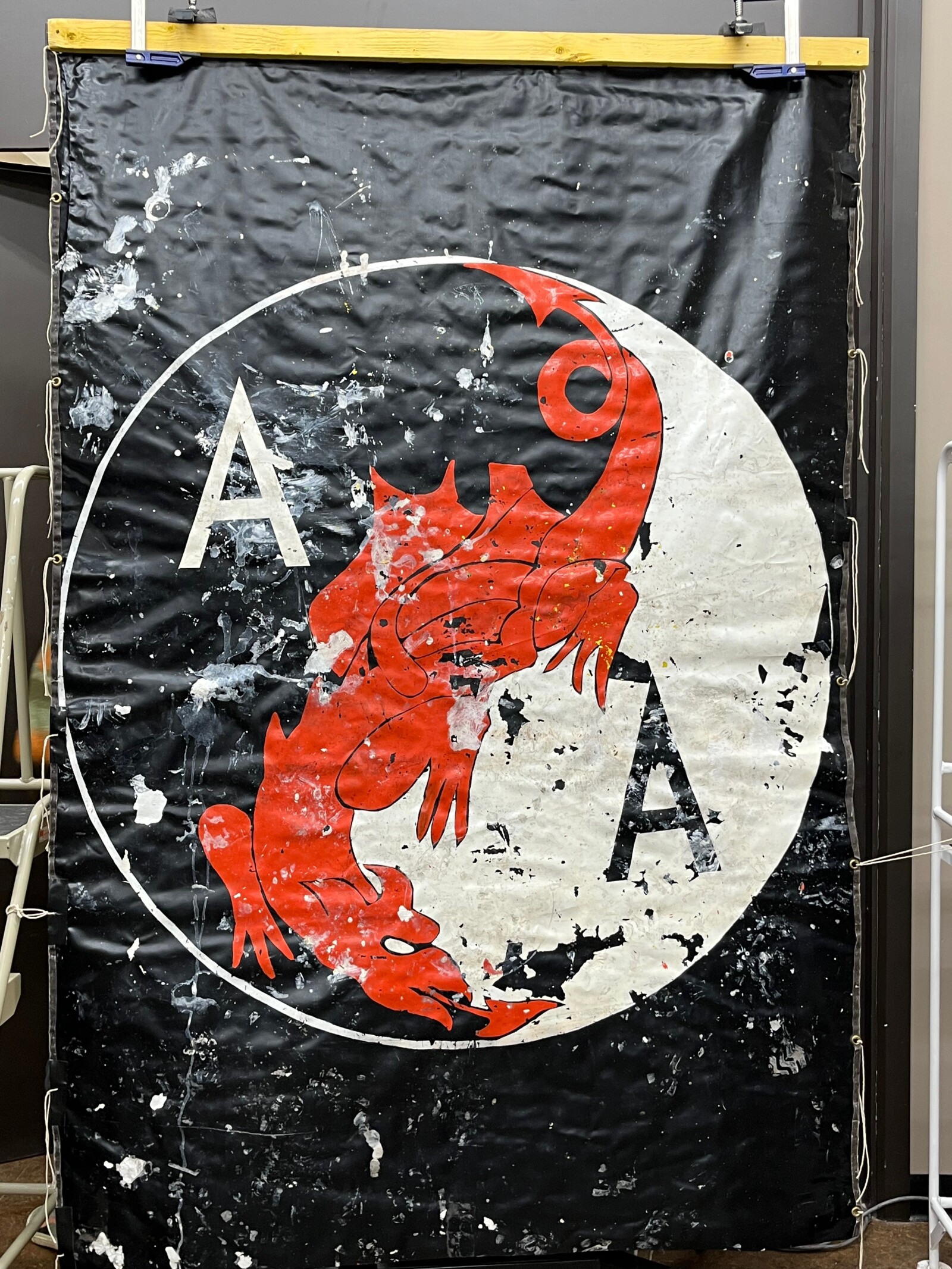
F2022.80.2 (Sanctions Now) Back After Conservation Treatment
© Anthony Evans. Photograph ©Amgueddfa Cymru – Museum Wales
Flaking paint on both sides of the banner was consolidated to prevent further loss of material. Lascaux Medium fur Konsolidierung was applied to the plastic surface with a soft bristle brush, before a silicone tipped tool and siliconized Melinex were used to press down the paint flakes.
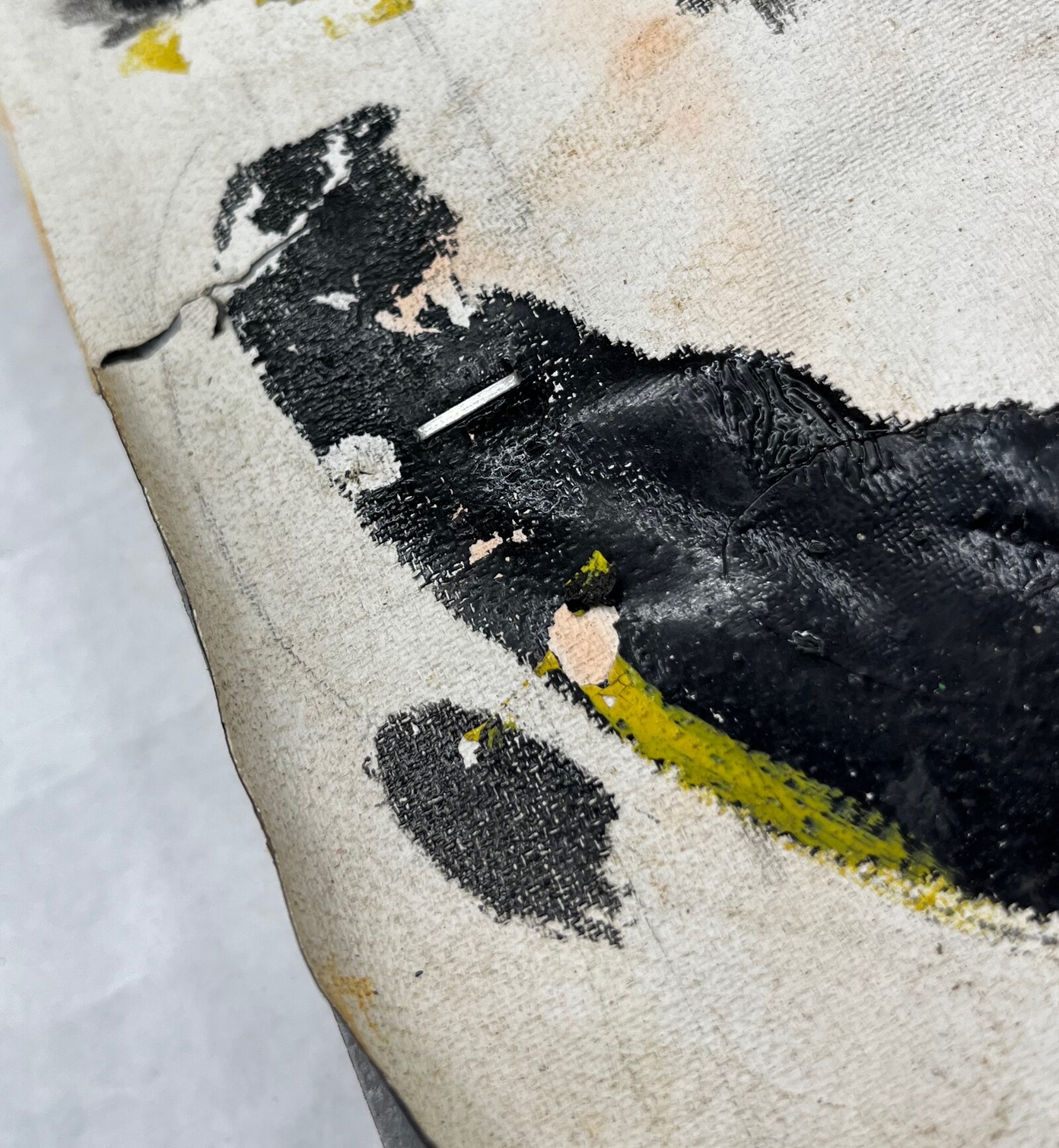
Sanctions Now Before Paint Consolidation
© Anthony Evans. Photograph ©Amgueddfa Cymru – Museum Wales
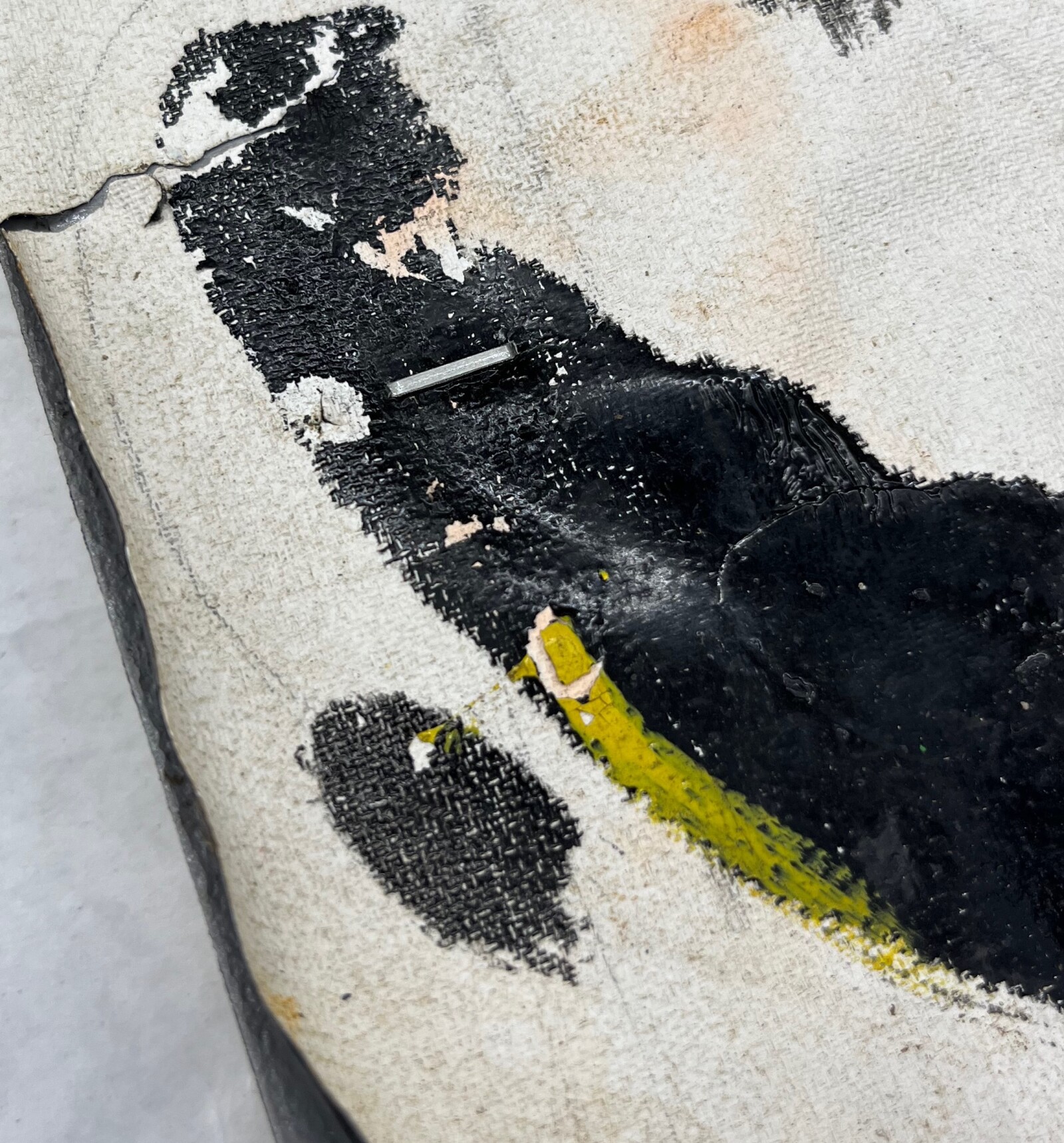
Sanctions Now After Paint Consolidation
© Anthony Evans. Photograph ©Amgueddfa Cymru – Museum Wales
Once the paint was secured, the banner needed to be cleaned. Smoke sponges were rolled across the surface of the banner to remove loose contaminants, such as dirt and dust, without causing stress to the plastic. The mould stains and residues were removed with a cotton swab dampened with Adjusted Water (pH 6.5).
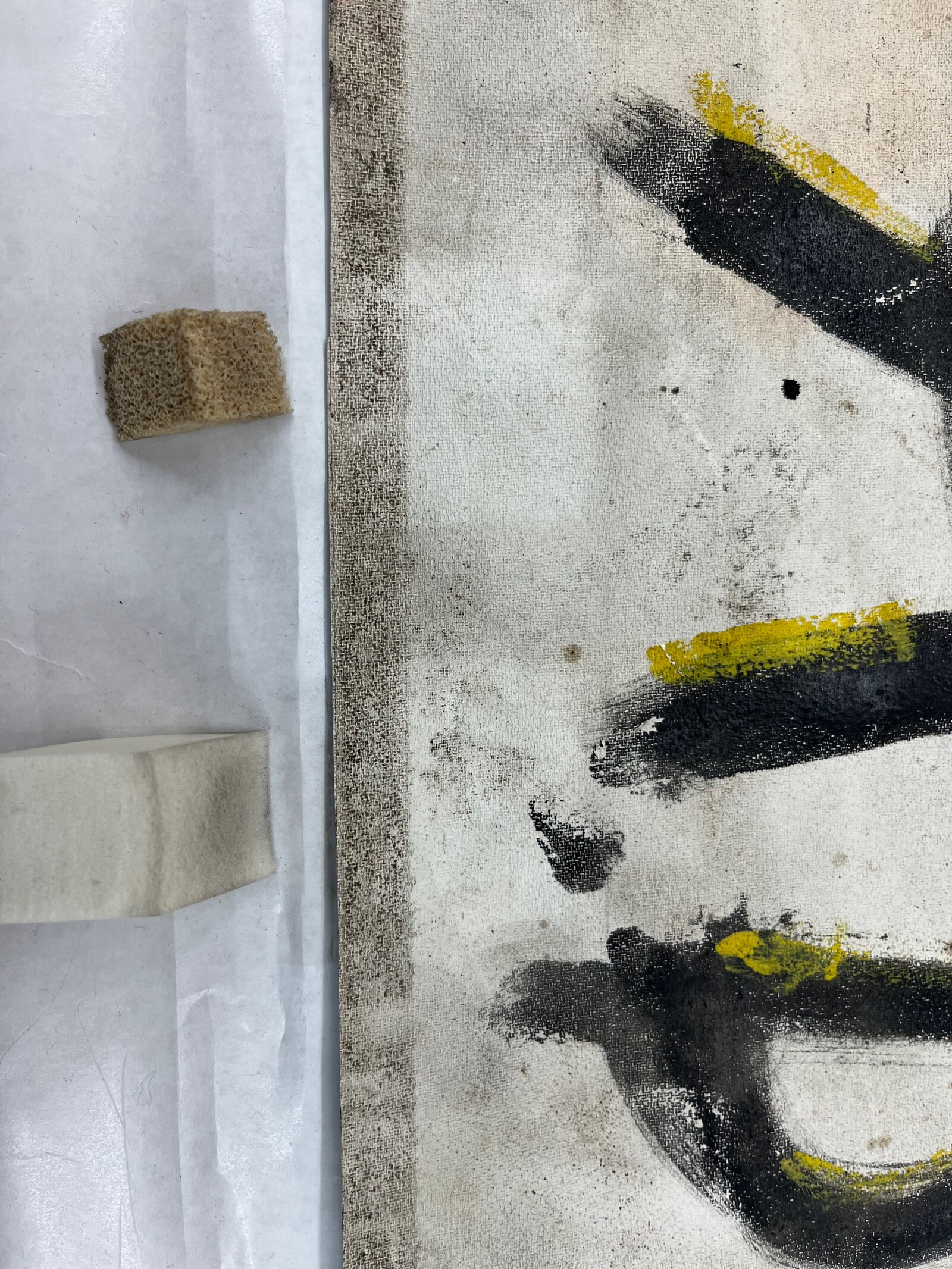
Sanctions Now Surface Cleaning Tests: Smoke Sponge (Left) vs Cosmetic Sponge (Right)
© Anthony Evans. Photograph ©Amgueddfa Cymru – Museum Wales
After conservation treatment was complete, Sanctions Now was wrapped around a large cardboard tube (40 cm x 2 m) covered in ALUVP. To prevent the banner from being in contact with itself when rolled, the banner was sandwiched between silicon coated paper before it was rolled. The silicon coated paper will prevent the transfer of paint. Polyester sail cloth was used to cover the rolled banner and protect it from dust. Cotton tape keeps the banner from unrolling.
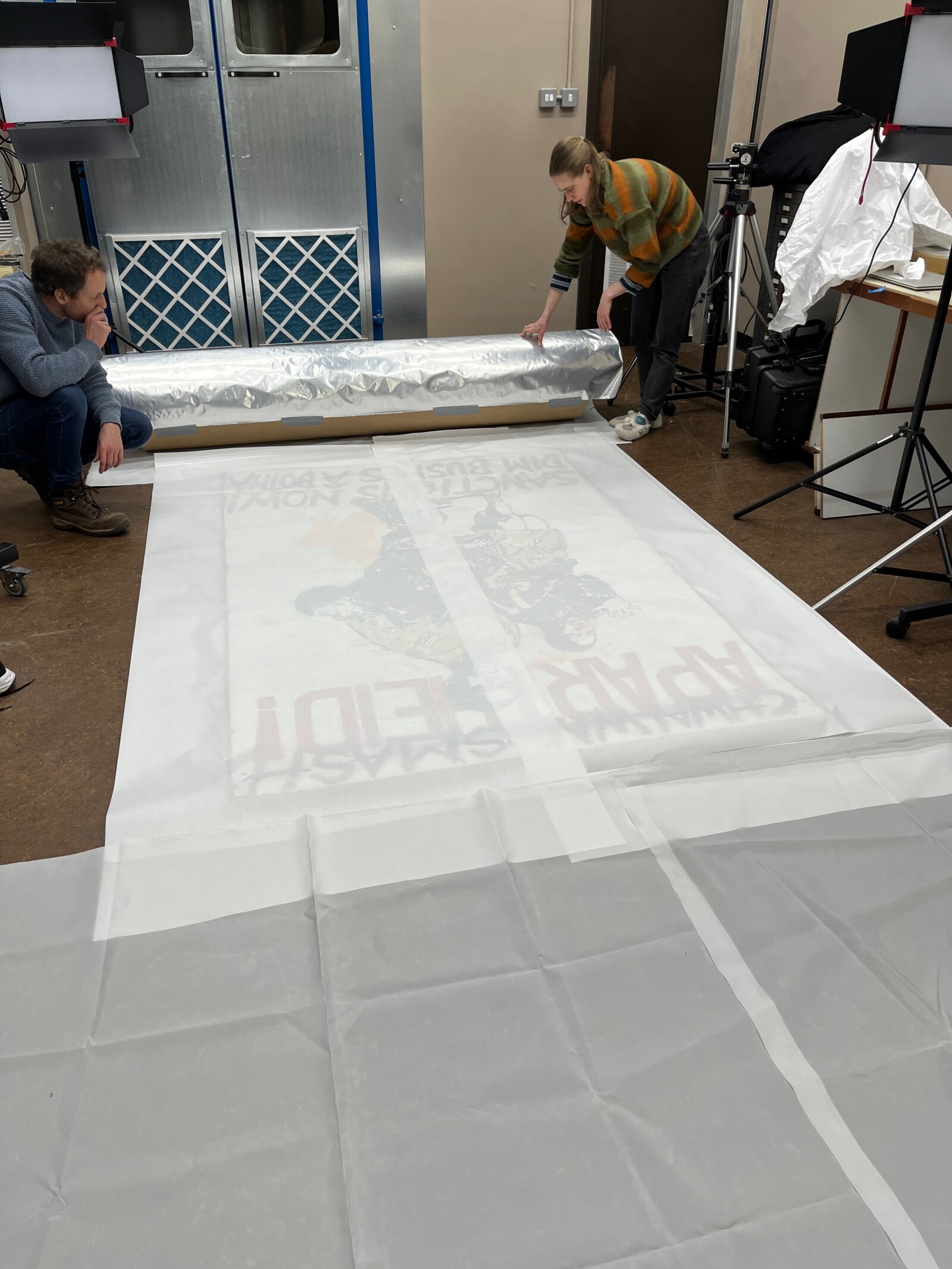
References:
Baker, A. 2016. This Photo Galvanized the World Against Apartheid. Her’s the Story Behind It.
Available at: https://time.com/4365138/soweto-anniversary-photograph/ (Accessed 9 June 2023)
The National Library of Wales. 2021. 40th Anniversary of Wales Anti-Apartheid Movement.
Available at: https://blog.library.wales/40th-anniversary-of-wales-anti-apartheid-movement/ (Accessed 7 June 2023)
The Welsh Group. 2023. Anthony Evans.
Available at: https://www.thewelshgroup-art.com/anthony-evans (Accessed 7 June 2023)